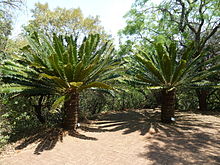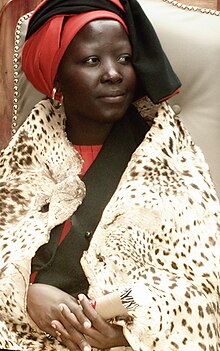Rain queen

The rain queen is the ruler of the Balobedu tribe (also known as the Lobedu people), who is known as Modjadji ("the woman who belongs to the sun") and belongs to the North Sotho language group in the South African province of Limpopo and in the area around Modjadjiskloof lives north of Tzaneen . The matrilineal title is only passed on to daughters. The queen is said to have rain-causing powers, which she passes on to her successor.
Origin (legend)
The ruling family itself claims to come from Egypt. Anthropologists believe that the family originated in the 16th century in Zimbabwe . According to legend, the Balobedu settled their current tribal area around 400 years ago after Princess Dzugundini and her supporters had to leave the pre-colonial Munhumutapa kingdom in southeast Zimbabwe. Reason: the princess was expecting a child from a relationship with her brother. Her mother gave the king's daughter various artifacts for making rain - colored pearls and parts of a ritual spear.
According to another source, the king himself is said to have had an incestuous relationship with his daughter and to have given her a magic horn when she was forced to leave. According to another version, the princess stole the rain-making artifacts from her father. Starting with Makalipe, who was born around 1600, the son of the expelled princess, six kings ruled the tribe for the next two centuries.
The queens
After the last king of the Balobedu, Mokoto (also: Mugodo), died around 1800, his daughter, Modjadji, became the first woman queen of the tribe. She is also said to have been his wife. She ruled for 54 years; after her death her daughter Masalanabo succeeded her. In 1896, Khesetoane became the third queen of the Balobedu. Their daughter Makoma became Rain Queen in 1959 and Mokope in 1981. Mokope's second-born daughter, Makheala, was chosen by her mother as her successor. Makheala died in 2001 - shortly before her mother - and was therefore unable to take up office.
In 2003 Makheala's daughter, Makobo, was crowned the youngest queen of the tribe to date. A king of the Venda put on her the traditional leopard skin. After her death due to illness on June 12, 2005, the throne remained vacant. (The official death rating was chronic meningitis ; the treating hospital referred to AIDS . Rumors cite Makobo's poisoning because of her traditional lifestyle as a further cause of death.) Makobo's daughter Masalanabo, born in 2005, is likely to be crowned the seventh queen of the tribe at the age of 22 become. Until then, the tribe is ruled by regents .
The previous queens were:
- 1800–1854: Maselekwane (Modjadji I.)
- 1854–1895: Masalanabo (Modjadji II.)
- 1896–1959: Khesetoane (Modjadji III.)
- 1959–1980: Makoma (Modjadji IV.)
- 1981–2001: Mokope (Modjadji V.)
- 2003–2005: Makobo (Modjadji VI.)
Rain ceremony
The most important event of the tribe is the rainy ceremony held annually in October at the beginning of spring. The celebration is presided over by the queen or, if she is not present, by the regent. The focus is on a sacred cow (Makhubo). The selected cow is sprayed with beer and celebrated by the participants with dances.
Importance and appreciation
The Rain Queen belongs to a group of regional rulers who have been guaranteed special rights in the constitution of South Africa. She is the only female tribal leader. She receives a small financial contribution from the government, is involved in local politics and is seen as a representative of her tribe. Theoretically eight chiefs (leaders of the chiefs, often women) and 300 matona ( chiefs ), who look after one or more villages, are subordinate to the queen . According to the traditional rules, the Modjadjis are not allowed to marry, but they are allowed to be given life and sexual partners selected by a council with whom they can father children.
As it is very popular in the region and the belief in its magical power was widespread in the past, it was and is treated with respect by the country's politicians. Shaka , the powerful king of the Zulu , is said to have already maintained a friendly relationship with her. The Swazi did not submit their tribe either. Frederik Willem de Klerk appreciated dealing with her. Nelson Mandela had closer contact with Modjadji V .; he sought their support for his presidential campaign in 1994 and funded a study abroad for Modjadji VI. President Thabo Mbeki paid tribute to the late Modjadji VI. as a symbol of hope and unity of the province and the whole country.
In 2006 the South African Navy named a submarine built by the Howaldtswerke in Kiel after the rain queen: the SAS Queen Modjadji (S 103) is used in patrol service in the Indian Ocean . Modjadji II (Masalanabo) is said to have been the inspiration for the novel She: A History of Adventure by Henry Rider Haggard , published in 1887 .
In 2016, the Rain Queen was officially recognized as Queen by the South African government under the Traditional Leadership and Governance Framework Act .
Individual evidence
- ↑ abcjournal.org, p. 427
- ↑ Bernhard Abend, Birgit Borowski, Anja Schliebitz: Baedeker Travel Guide South Africa, Swaziland, Lesotho. ISBN 978-3-8297-9461-9 , Mair Dumont, 2015, p. 548
- ↑ The photo shows specimens of the Botanical National Park in Pretoria
- ^ Ernst Kindhauser, Makoko Modjadji (1978-2005) , Die Weltwoche
- ^ A b c Michael Wines, Rain Queen Is Dead, but Debate Over Her Power Lives On , The New York Times , June 21, 2005
- ^ A b c Bonnie G. Smith, The Oxford Encyclopedia of Women in World History , ISBN 978-0-19-514890-9 , Oxford University Press, USA, 2008, p. 283
- ↑ a b Scott Calvert, cloud of mystery shrouds the land of the rain queen , 21 June 2005 The Baltimore Sun
- ↑ a b c d Donald G. McNeil Jr., Modjadji Journal; Even Into Rain Queen's Life, Some Rain Must Fall , The New York Times, April 30, 1998
- ↑ a b Ceremonial enthronement with the Balobedu people A new “rain queen” in South Africa , April 12, 2003, Neue Zürcher Zeitung
- ^ Rain Queen's mysterious death could signal end of dynasty , June 21, 2005, The Telegraph .
- ↑ Eleven year old is supposed to be the rain queen in South Africa Der Spiegel from March 31, 2016, accessed April 4, 2016
- ^ Willem Steenkamp, The misty, magical story of Modjadji, the Rain Queen , June 18, 2014, South Arican Tourism
- ↑ a b Odile Jolys, The power of ancestors, October 6, 2006 The African Times ( page no longer available , search in web archives ) Info: The link was automatically marked as broken. Please check the link according to the instructions and then remove this notice.
- ↑ Global Warming, Rick Perry And The South African Rain Queen by Pam Grout in The Huffington Post , December 11, 2011
- ↑ SSK Manthatisi Class (Type 209/1400) Attack Submarine, South Africa , naval-technology.com
- ^ Queen Modjadji V: South African monarch in charge of the rain by Belinda Beresford, in The Guardian , July 3, 2001
- ↑ Rain queen finally recognized. sowetanlive.co.za from May 30, 2016 (English), accessed June 2, 2016
Web links
- Rain Queens of Africa (English)
- South African Tourism (English)
- Queen Modjadji in The Economist , July 5, 2001
- Harald Stutte, African Dynasty: Drought in the Land of the Rain Queen , December 10, 2004, Spiegel Online
- Rain Queen is the “guarantor of life” , ethnologist Elfriede Höckner in an interview, July 6, 2005, dieStandard.at
literature
- Elfriede Höckner: The Lobedu of South Africa: Myth and Reality of the Rain Queen Modjadji. Diss., ISBN 3-515-06794-9 , Franz Steiner Verlag, Stuttgart 1998 ( partly available online )
- Piotr Naskrecki, Cristina Goettsch Mittermeier: Relics: Travels in Nature's Time Machine. ISBN 978-0-226-56870-6 , University of Chicago Press, Chicago 2011, p. 151
